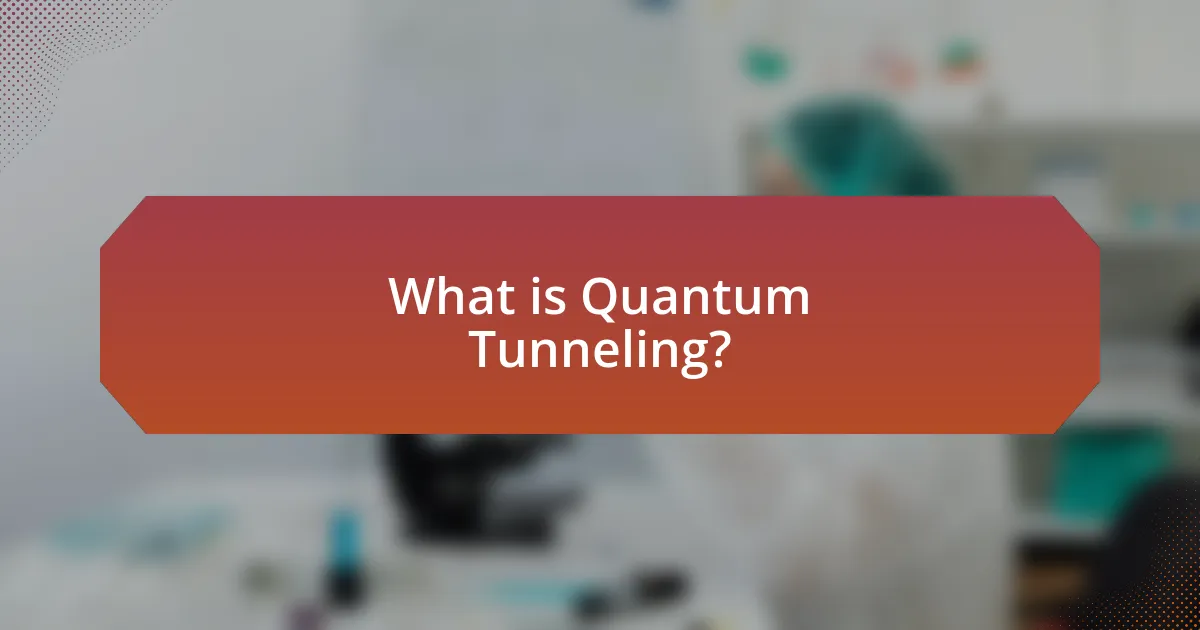Quantum tunneling is a quantum mechanical phenomenon where particles can pass through potential energy barriers that classical physics deems insurmountable. This article explores the mechanisms behind quantum tunneling, including the wave-particle duality and the uncertainty principle, and discusses its significance in various fields such as nuclear fusion, chemical reactions, and modern electronics. It also examines the implications of quantum tunneling in technology, including its role in quantum computing and semiconductor devices, as well as the challenges it presents. Additionally, the article highlights experimental methods for observing quantum tunneling and considers future prospects and potential applications in medicine.

What is Quantum Tunneling?
Quantum tunneling is a quantum mechanical phenomenon where particles pass through potential energy barriers that they classically should not be able to surmount. This occurs due to the wave-like properties of particles, allowing them to exist in a superposition of states, which enables them to penetrate barriers even when their energy is lower than the barrier height. Experimental evidence supporting quantum tunneling includes observations in nuclear fusion, where protons overcome electrostatic repulsion to fuse in stars, and in the operation of tunnel diodes, which exploit this effect for electronic applications.
How does Quantum Tunneling occur?
Quantum tunneling occurs when a particle passes through a potential energy barrier that it classically should not be able to surmount. This phenomenon is explained by quantum mechanics, where particles exhibit wave-like properties, allowing them to exist in a superposition of states. When a particle encounters a barrier, there is a probability that it can “tunnel” through the barrier rather than reflecting off it, due to its wavefunction extending into the barrier region. This effect has been experimentally validated in various contexts, such as in nuclear fusion, where protons tunnel through the Coulomb barrier, enabling fusion reactions at temperatures lower than would be expected classically.
What are the fundamental principles behind Quantum Tunneling?
Quantum tunneling occurs when a particle passes through a potential energy barrier that it classically should not be able to surmount. This phenomenon is fundamentally rooted in the principles of quantum mechanics, particularly the wave-particle duality and the uncertainty principle.
Wave-particle duality suggests that particles, such as electrons, exhibit both wave-like and particle-like properties. When a particle encounters a barrier, its wave function does not abruptly stop; instead, it extends into and beyond the barrier, allowing for a non-zero probability of finding the particle on the other side. The uncertainty principle, formulated by Werner Heisenberg, indicates that the exact position and momentum of a particle cannot be simultaneously known, which contributes to the particle’s ability to “tunnel” through barriers.
Experimental evidence supporting quantum tunneling includes phenomena such as alpha decay in nuclear physics, where alpha particles escape from the nucleus despite insufficient energy to overcome the nuclear potential barrier. This behavior aligns with predictions made by quantum mechanics, confirming the validity of the principles behind quantum tunneling.
How do wave functions relate to Quantum Tunneling?
Wave functions describe the quantum state of a particle and are fundamental to understanding quantum tunneling. In quantum mechanics, a wave function represents the probability amplitude of a particle’s position and momentum, allowing for the calculation of the likelihood of finding a particle in a specific location.
In the context of quantum tunneling, when a particle encounters a potential energy barrier, its wave function does not abruptly drop to zero at the barrier; instead, it penetrates the barrier, albeit with a decreasing amplitude. This phenomenon indicates that there is a non-zero probability of the particle being found on the other side of the barrier, despite classical physics suggesting that it should not be able to cross it.
The mathematical formulation of quantum tunneling is supported by the Schrödinger equation, which governs the behavior of wave functions. This equation shows that the wave function can extend into classically forbidden regions, leading to the conclusion that particles can tunnel through barriers. Thus, the relationship between wave functions and quantum tunneling is that wave functions provide the framework for understanding how particles can probabilistically pass through barriers that would otherwise be insurmountable according to classical mechanics.
Why is Quantum Tunneling significant in physics?
Quantum tunneling is significant in physics because it explains how particles can pass through energy barriers that classical physics deems insurmountable. This phenomenon is crucial in various processes, such as nuclear fusion in stars, where protons overcome electrostatic repulsion to fuse, releasing energy. Additionally, quantum tunneling is fundamental in technologies like tunnel diodes and scanning tunneling microscopes, which rely on the ability of electrons to tunnel through barriers. The significance of quantum tunneling is further validated by experimental observations, such as the tunneling effect observed in alpha decay, where alpha particles escape from the nucleus despite insufficient energy to overcome the nuclear potential barrier.
What role does Quantum Tunneling play in nuclear fusion?
Quantum tunneling is essential for nuclear fusion as it allows particles, such as protons, to overcome the electrostatic repulsion between them at lower energies than classical physics would predict. In nuclear fusion, two atomic nuclei must come close enough for the strong nuclear force to take effect, but the repulsive force due to their positive charges creates a barrier. Quantum tunneling enables these particles to “tunnel” through this barrier, facilitating fusion reactions even at the high temperatures and pressures found in stars. This phenomenon is supported by experimental evidence, such as the observed fusion rates in stars, which align with predictions made by quantum mechanics regarding tunneling probabilities.
How does Quantum Tunneling affect chemical reactions?
Quantum tunneling significantly affects chemical reactions by allowing particles to pass through energy barriers that they would not be able to overcome classically. This phenomenon enables reactions to occur at lower energy levels and faster rates than would be predicted by classical mechanics. For instance, in the case of hydrogen transfer reactions, quantum tunneling can increase the reaction rate by several orders of magnitude, as demonstrated in studies such as those by W. H. Miller, which show that tunneling plays a crucial role in the kinetics of these reactions. Thus, quantum tunneling is essential for understanding reaction mechanisms and rates in various chemical processes.

What are the implications of Quantum Tunneling in technology?
Quantum tunneling has significant implications in technology, particularly in the fields of electronics and quantum computing. In electronics, quantum tunneling enables the operation of devices like tunnel diodes and flash memory, which rely on the ability of electrons to pass through potential barriers, enhancing speed and efficiency. In quantum computing, tunneling allows qubits to exist in multiple states simultaneously, facilitating faster processing and complex calculations. Research has shown that quantum tunneling is essential for the development of advanced technologies, such as quantum sensors and secure communication systems, which leverage the principles of quantum mechanics to achieve unprecedented performance and security.
How is Quantum Tunneling utilized in modern electronics?
Quantum tunneling is utilized in modern electronics primarily in the operation of transistors and tunnel diodes. In transistors, quantum tunneling allows electrons to pass through energy barriers, enabling faster switching speeds and lower power consumption. Tunnel diodes exploit this phenomenon to achieve negative resistance, which is essential for high-frequency oscillators and amplifiers. The practical application of quantum tunneling in these devices enhances performance metrics such as speed and efficiency, making it a fundamental principle in the design of advanced electronic components.
What are quantum tunneling transistors and how do they work?
Quantum tunneling transistors are semiconductor devices that utilize the quantum tunneling effect to switch electrical signals. In these transistors, electrons can pass through an energy barrier that would typically be insurmountable according to classical physics, allowing for faster switching speeds and lower power consumption compared to traditional transistors. This phenomenon occurs because, at the quantum level, particles like electrons exhibit wave-like properties, enabling them to “tunnel” through barriers rather than going over them. Research has shown that quantum tunneling transistors can operate at speeds exceeding 100 GHz, significantly enhancing performance in electronic circuits.
How does Quantum Tunneling contribute to the development of quantum computing?
Quantum tunneling significantly contributes to the development of quantum computing by enabling qubits to transition between states more efficiently than classical bits. This phenomenon allows qubits to exist in superposition, where they can represent multiple states simultaneously, enhancing computational power. For instance, quantum tunneling facilitates faster processing speeds and reduces energy consumption in quantum circuits, as seen in superconducting qubits that leverage tunneling effects to achieve coherence times necessary for complex calculations.
What challenges does Quantum Tunneling present in technology?
Quantum tunneling presents significant challenges in technology, particularly in the fields of semiconductor design and quantum computing. In semiconductor devices, quantum tunneling can lead to leakage currents, which reduce the efficiency and performance of transistors, especially as they shrink in size. For instance, as transistors approach nanoscale dimensions, the probability of tunneling increases, causing unwanted power loss and heat generation. In quantum computing, maintaining coherence is difficult due to tunneling effects, which can lead to errors in qubit states. This challenge is highlighted in research by Devoret and Schoelkopf (2013), which discusses how quantum tunneling impacts qubit stability and error rates in superconducting circuits.
What are the limitations of Quantum Tunneling in semiconductor devices?
Quantum tunneling in semiconductor devices is limited by factors such as temperature sensitivity, material properties, and device geometry. At elevated temperatures, increased phonon interactions can disrupt tunneling processes, leading to reduced efficiency. Additionally, the effectiveness of tunneling is influenced by the barrier height and width; thicker barriers or higher energy barriers significantly decrease the tunneling probability. Furthermore, in nanoscale devices, quantum effects can lead to variability in performance, making it challenging to achieve consistent results across different devices. These limitations highlight the complexities involved in optimizing quantum tunneling for practical applications in semiconductor technology.
How can Quantum Tunneling lead to energy loss in circuits?
Quantum tunneling can lead to energy loss in circuits by allowing electrons to pass through potential barriers instead of overcoming them, resulting in reduced energy transfer efficiency. This phenomenon occurs when electrons tunnel through insulating barriers in semiconductor devices, such as transistors, leading to leakage currents. These leakage currents can dissipate energy as heat, contributing to overall energy loss in the circuit. Studies have shown that in nanoscale devices, quantum tunneling becomes significant, and the energy loss can be quantified; for instance, in modern transistors, leakage currents can account for up to 30% of total power consumption in certain applications.

How can we observe and measure Quantum Tunneling?
Quantum tunneling can be observed and measured using techniques such as scanning tunneling microscopy (STM) and quantum interference experiments. Scanning tunneling microscopy allows scientists to visualize the tunneling of electrons at the atomic level, providing direct evidence of quantum tunneling phenomena. In quantum interference experiments, particles such as electrons are passed through a barrier, and the resulting interference patterns confirm the occurrence of tunneling, as demonstrated in experiments like the double-slit experiment with electrons. These methods provide concrete evidence of quantum tunneling by showcasing the behavior of particles as they traverse potential barriers that classical physics would deem insurmountable.
What experimental methods are used to study Quantum Tunneling?
Experimental methods used to study quantum tunneling include scanning tunneling microscopy (STM), time-resolved spectroscopy, and tunneling spectroscopy. Scanning tunneling microscopy allows researchers to visualize and manipulate individual atoms, providing insights into tunneling phenomena at the atomic level. Time-resolved spectroscopy measures the dynamics of tunneling events by capturing the time evolution of particles as they tunnel through barriers, enabling the observation of tunneling timescales. Tunneling spectroscopy, often employed in condensed matter physics, analyzes the tunneling current as a function of voltage to extract information about the energy levels and states involved in the tunneling process. These methods collectively enhance the understanding of quantum tunneling and its implications in various physical systems.
How do tunneling microscopes work in observing Quantum Tunneling?
Tunneling microscopes, specifically scanning tunneling microscopes (STM), observe quantum tunneling by measuring the tunneling current that occurs when a conductive tip is brought very close to a conductive surface. As the tip approaches the surface, electrons can tunnel through the potential barrier between the tip and the surface, generating a measurable current that is directly related to the distance between the tip and the surface. This tunneling current allows for the imaging of surfaces at the atomic level, providing insights into the electronic properties of materials and the behavior of particles as they pass through barriers, a phenomenon described by quantum mechanics. The ability of STMs to achieve atomic resolution demonstrates the practical application of quantum tunneling principles in experimental physics.
What are the challenges in measuring Quantum Tunneling events?
Measuring quantum tunneling events presents significant challenges due to the inherently probabilistic nature of quantum mechanics. The primary difficulty lies in the fact that quantum tunneling occurs on extremely short timescales and at the atomic or subatomic level, making it difficult to observe directly. Additionally, the phenomenon is influenced by various factors such as the energy barrier height and width, which complicates the measurement process. Experimental setups often require sophisticated technology, such as ultra-fast lasers or advanced detectors, to capture the fleeting moments of tunneling. Furthermore, the interpretation of results can be ambiguous due to the wave-particle duality of particles, which adds another layer of complexity to understanding and measuring these events accurately.
What are the future prospects of Quantum Tunneling research?
The future prospects of Quantum Tunneling research are promising, particularly in fields such as quantum computing, nanotechnology, and materials science. Advancements in quantum computing rely on the principles of quantum tunneling to enhance processing speeds and efficiency, as demonstrated by research from IBM and Google, which shows that tunneling can facilitate faster qubit operations. Additionally, in nanotechnology, quantum tunneling is crucial for the development of smaller and more efficient electronic components, as evidenced by studies published in journals like Nature Nanotechnology, highlighting the role of tunneling in the performance of nanoscale devices. Furthermore, ongoing research into quantum tunneling phenomena may lead to breakthroughs in energy transfer processes, potentially impacting renewable energy technologies.
How might advancements in Quantum Tunneling impact future technologies?
Advancements in quantum tunneling could significantly enhance future technologies by enabling faster and more efficient electronic components. For instance, quantum tunneling allows electrons to pass through energy barriers, which can lead to the development of ultra-fast transistors and improved semiconductor devices. Research indicates that utilizing quantum tunneling in computing could result in processors that operate at speeds far exceeding current silicon-based technologies, potentially achieving processing speeds in the terahertz range. This capability is supported by studies demonstrating that quantum tunneling effects can be harnessed in nanoscale devices, paving the way for innovations in quantum computing and energy-efficient electronics.
What are the potential applications of Quantum Tunneling in medicine?
Quantum tunneling has potential applications in medicine, particularly in drug delivery and cancer treatment. In drug delivery, quantum tunneling can facilitate the transport of molecules across cellular membranes, enhancing the efficacy of medications. For instance, research indicates that nanoparticles can utilize quantum tunneling to penetrate biological barriers, improving targeted therapy outcomes. In cancer treatment, quantum tunneling may enable the precise targeting of cancer cells while minimizing damage to surrounding healthy tissue, as demonstrated in studies exploring the behavior of particles at the quantum level. These applications highlight the transformative potential of quantum tunneling in advancing medical technologies and therapies.
What practical tips can enhance understanding of Quantum Tunneling?
To enhance understanding of quantum tunneling, one practical tip is to visualize the concept using analogies, such as comparing it to a ball rolling over a hill, where the ball can sometimes appear on the other side without having enough energy to climb over. This analogy helps illustrate how particles can pass through energy barriers despite classical expectations. Additionally, studying graphical representations of potential energy barriers and wave functions can provide insight into how quantum mechanics describes tunneling. Engaging with simulations or interactive models that demonstrate tunneling phenomena can further solidify comprehension by allowing learners to manipulate variables and observe outcomes in real-time.




